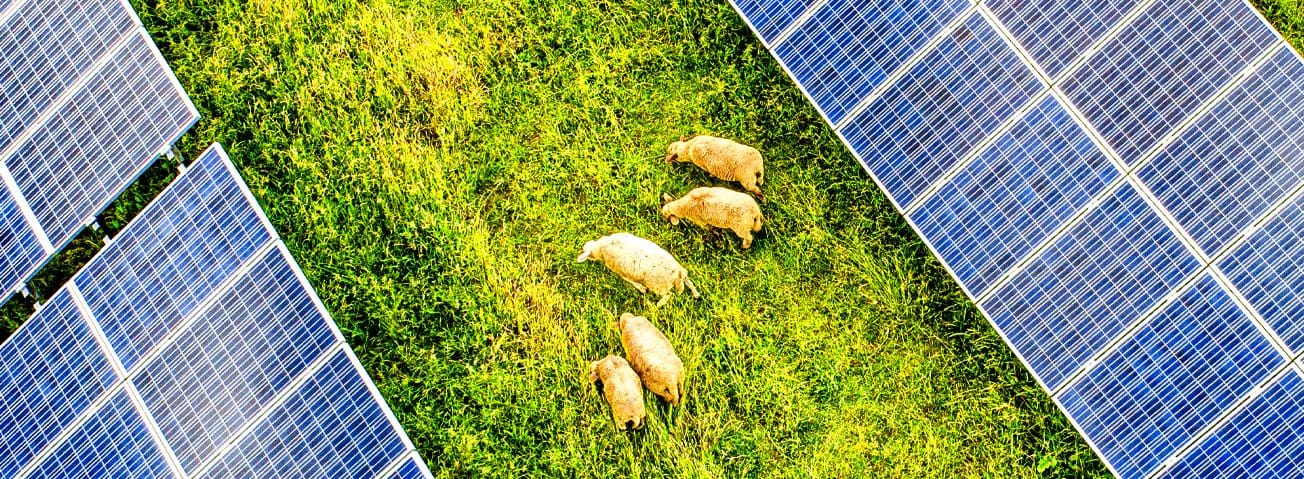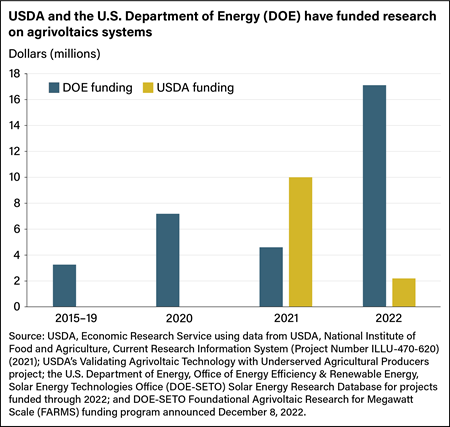Common Ground for Agriculture and Solar Energy: Federal Funding Supports Research and Development in Agrivoltaics

Agrivoltaics is the combination of solar panels and agricultural production at the same location. Traditionally agrivoltaics referred to systems with crops—typically fruits or vegetables—grown under solar panels, but the term has evolved to include combining solar panels with grazing livestock (mainly sheep) and planting native grasses or pollinator habitat beneath solar panels. The practice was developed in part to allow for expanded solar development to address climate change without the land-use challenges often associated with large-scale solar operations.
Federal agencies, including USDA and the U.S. Department of Energy have provided funding to this emerging sector. The funding provided by DOE more than tripled from 2021 to 2022 (see chart) and included $8 million through a new initiative focused on examining the benefits of agrivoltaics for farmers and rural communities.
USDA provided $10 million for agrivoltaics research through the USDA, National Institute of Food and Agriculture in 2021 and $2.2 million through the Partnerships for Climate-Smart Commodities in 2022 among other funding. Additionally, the USDA, Agricultural Research Service initiated three agrivoltaics research projects in 2023. One of those projects explores sustainable agricultural systems in the northern Great Plains and assesses the viability of locating solar panels on livestock grazing pasture. The other two focus on evaluating and developing best practices for managing crop and livestock agrivoltaics systems in the Southwest.
As of 2024, agrivoltaics systems are predominantly those that have grasses, often native grasses, pollinator-friendly vegetation, or both grown beneath solar panels. Just over one fourth of agrivoltaics sites combine solar panels and sheep grazing. Less than 5 percent of sites include crops grown beneath solar panels, typically fruits or vegetables. Agrivoltaics systems are often smaller than large-scale, commercial solar farms: 70 percent have a capacity of less than 5 megawatts, although they range from sites with less than 0.01 megawatt of capacity to sites with 660 megawatts of capacity. The agrivoltaics sector continues to evolve as researchers explore ways to jointly produce clean energy from solar panels and agricultural products.
Trends, Insights, and Future Prospects for Production in Controlled Environment Agriculture and Agrivoltaics Systems, by Erik Dohlman, Karen Maguire, Wilma V. Davis, Megan Husby, John Bovay, Catharine Weber, and Yoonjung Lee, ERS, January 2024
Agrivoltaics could bring agriculture and renewable energy together, by Lawrence, M. , U.S. Department of Agriculture, National Institute of Food and Agriculture, June 30, 2023
Agrivoltaics map, by InSPIRE research team, U.S. Department of Energy, National Renewable Energy Laboratory
Agrivoltaics: Coming soon to a farm near you?, U.S. Department of Agriculture, Climate Hubs
Agrivoltaics: Pairing Solar Power and Agriculture in the Northwest?, U.S. Department of Agriculture, Climate Hubs
Partnerships for Climate-Smart Commodities, U.S. Department of Agriculture
Funding notice: Foundational agrivoltaics research for megawatt scale (FARMS), U.S. Department of Energy, Solar Energy Technologies Office, May 05, 2022
Agrivoltaics: Solar and agriculture co-location, by Solar Energy Technologies Office, U.S. Department of Energy, Solar Energy Technologies Office


